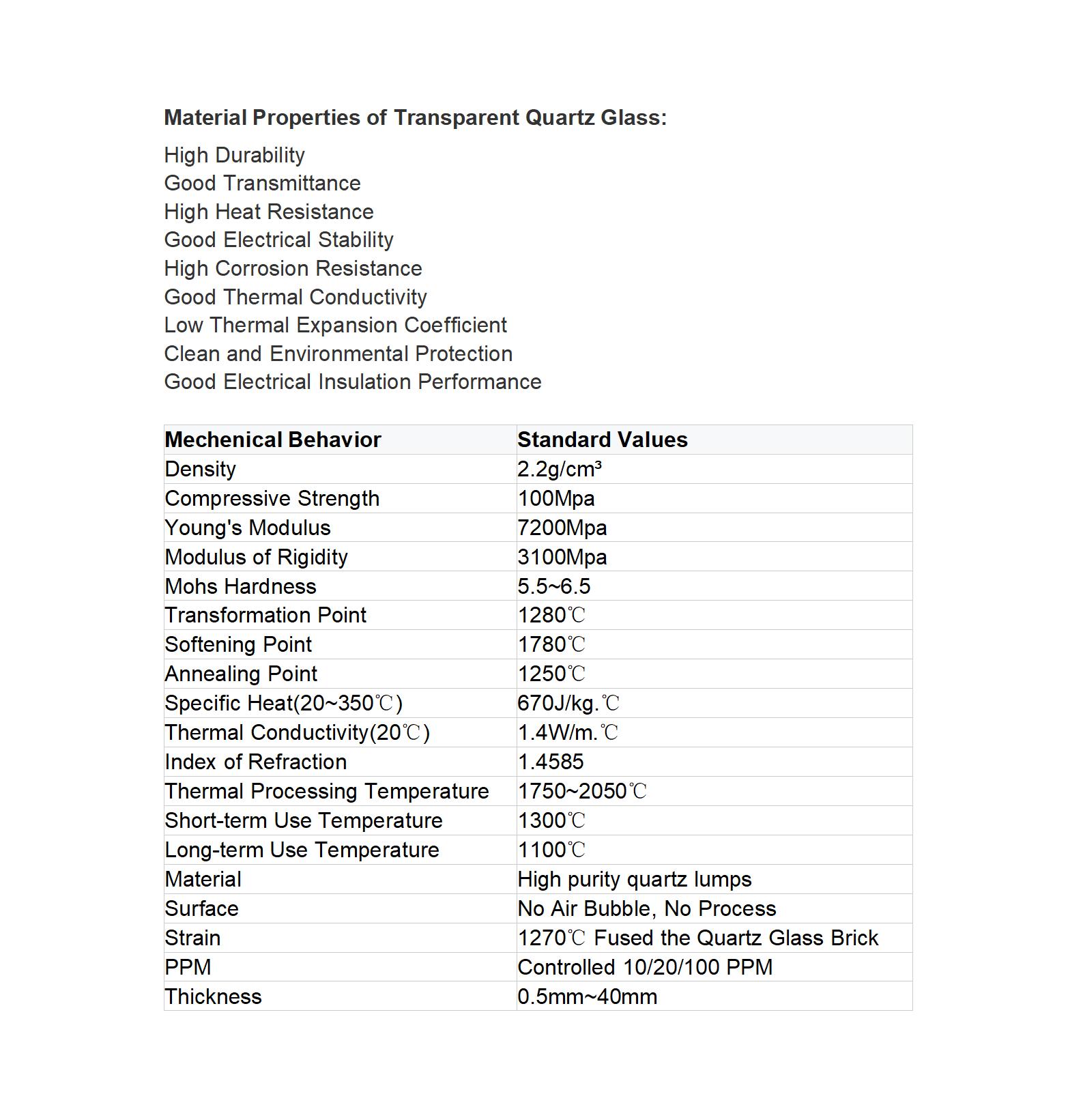T: +86-518-85528012
E: nick@luverrequartz.com
E: nick@luverrequartz.com
1st floor Runlian industrial center No. 116 QuFeng Rd., Haizhou Economic and technological development zone Lianyungang City, Jiangsu Province, China 222062
High transmittance transparent quartz glass sheet
High transmittance transparent quartz glass sheet is a special industrial technology glass with a series of excellent properties that are unparalleled by ordinary glass.
LUVERRE quartz
99.99%
Inner with Vacuum PVC bag and then wrapped with air bubble film, outer with wooden box.
as per customer's requirement
| Availability: | |
|---|---|
High transmittance transparent quartz glass sheet
High transmittance transparent quartz glass sheet is a special industrial technology glass with a series of excellent properties that are unparalleled by ordinary glass. It is mainly made by melting high-purity natural quartz (such as crystal, quartz sand), and its main component is silicon dioxide (SiO ₂). Quartz glass is known for its extremely small coefficient of linear expansion (only 1/10~1/20 of ordinary glass) and excellent thermal shock resistance, which can maintain stability under extreme temperature conditions. The commonly used temperature range is 1100~1200 ℃, and it can withstand high temperatures up to 1400 ℃ in the short term.

In terms of optical performance, the transmittance of quartz glass varies depending on the type and wavelength range. Generally speaking, optical quartz glass has a high transmittance in the visible light region, usually above 90%, and some can even reach around 92%. If one or more layers of magnesium fluoride anti reflective film are coated on the surface of the lens, its transmittance can reach 99.2%. In the ultraviolet spectral region, especially for far ultraviolet quartz glasses (such as JGS1), their performance is outstanding in this area, with a maximum transmittance of over 80%. In the infrared spectral range, optical quartz glass also has good transparency, for example, some infrared quartz glasses (such as JGS3) have high transmittance in specific infrared bands.
The structural characteristic of quartz glass is that it is an amorphous material composed of a single silicon dioxide component, and its microstructure presents a short-range ordered and long-range disordered state. In addition, the Si-O chemical bond energy is strong and stable, and this amorphous structure gives quartz glass many unique physical and chemical properties, such as excellent spectral transparency, extremely low thermal expansion coefficient and conductivity, as well as excellent radiation resistance and long lifespan under extreme conditions.
These characteristics make quartz glass irreplaceable in many fields, such as high-end laboratory equipment, extraction devices for special high-purity products, and areas that require excellent optical performance glass.

High transmittance transparent quartz glass sheet is an important material widely used in optics, semiconductors, chemistry, medical and other fields.
High transmittance transparent quartz glass sheet
High transmittance transparent quartz glass sheet is a special industrial technology glass with a series of excellent properties that are unparalleled by ordinary glass. It is mainly made by melting high-purity natural quartz (such as crystal, quartz sand), and its main component is silicon dioxide (SiO ₂). Quartz glass is known for its extremely small coefficient of linear expansion (only 1/10~1/20 of ordinary glass) and excellent thermal shock resistance, which can maintain stability under extreme temperature conditions. The commonly used temperature range is 1100~1200 ℃, and it can withstand high temperatures up to 1400 ℃ in the short term.

In terms of optical performance, the transmittance of quartz glass varies depending on the type and wavelength range. Generally speaking, optical quartz glass has a high transmittance in the visible light region, usually above 90%, and some can even reach around 92%. If one or more layers of magnesium fluoride anti reflective film are coated on the surface of the lens, its transmittance can reach 99.2%. In the ultraviolet spectral region, especially for far ultraviolet quartz glasses (such as JGS1), their performance is outstanding in this area, with a maximum transmittance of over 80%. In the infrared spectral range, optical quartz glass also has good transparency, for example, some infrared quartz glasses (such as JGS3) have high transmittance in specific infrared bands.
The structural characteristic of quartz glass is that it is an amorphous material composed of a single silicon dioxide component, and its microstructure presents a short-range ordered and long-range disordered state. In addition, the Si-O chemical bond energy is strong and stable, and this amorphous structure gives quartz glass many unique physical and chemical properties, such as excellent spectral transparency, extremely low thermal expansion coefficient and conductivity, as well as excellent radiation resistance and long lifespan under extreme conditions.
These characteristics make quartz glass irreplaceable in many fields, such as high-end laboratory equipment, extraction devices for special high-purity products, and areas that require excellent optical performance glass.

High transmittance transparent quartz glass sheet is an important material widely used in optics, semiconductors, chemistry, medical and other fields.